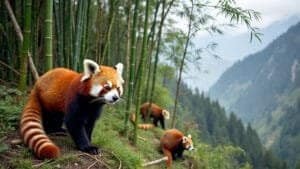Introduction
Red pandas are not only fascinating creatures but also key contributors to the health and balance of bamboo forest ecosystems
As selective feeders, red pandas help regulate bamboo growth, ensuring that bamboo forests remain healthy and diverse. Their behavior promotes the regeneration of bamboo, supporting the overall ecosystem by providing food and habitat for a variety of species
This article explores how red pandas contribute to maintaining the balance of bamboo forests, their role in biodiversity, and the impacts of their decline on these vital ecosystems
How Red Pandas Influence Bamboo Growth
Red pandas play an essential role in influencing the growth of bamboo within the forests they inhabit. As selective feeders, they consume bamboo in a way that regulates its growth, promotes regeneration, and ensures a healthy balance within the forest ecosystem
By controlling bamboo populations, red pandas contribute to the stability of these ecosystems, preventing overgrowth and maintaining the natural cycle of bamboo growth and regeneration
Selective Feeding and Bamboo Regeneration
Red pandas are highly selective feeders, choosing to consume only certain parts of the bamboo plant, such as the tender shoots and leaves. By feeding on these specific parts, red pandas help prune the bamboo, allowing for new growth to occur
This selective feeding behavior stimulates bamboo regeneration by encouraging the development of fresh shoots, which are vital for the continuous cycle of bamboo growth. In this way, red pandas play a direct role in the natural pruning of bamboo forests, ensuring that the plant remains healthy and capable of sustaining itself over time
Research by Yonzon and Hunter (1991) highlights the importance of red pandas’ selective feeding habits in maintaining bamboo forest balance
Their feeding not only benefits the red pandas themselves but also promotes the health and vitality of the bamboo species, which in turn supports a wide variety of other organisms in the ecosystem
Controlling Bamboo Overgrowth
Bamboo is known for its rapid growth and can sometimes become invasive if left unchecked. By consuming significant amounts of bamboo, red pandas help regulate its spread within the forest
This control of bamboo overgrowth is crucial for maintaining a balanced ecosystem, as unchecked bamboo can dominate the forest floor, limiting the growth of other plant species and reducing overall biodiversity
Red pandas, by feeding on bamboo, keep its growth in check, preventing it from overcrowding the forest and allowing a variety of plant species to flourish alongside it
In regions where red pandas are present, bamboo forests tend to exhibit greater species diversity because the red pandas help prevent bamboo from becoming too dominant. This balance is critical for the health of the ecosystem, as it supports a range of wildlife that depends on different plants and habitats within the forest
Studies by Wei et al. (1999) emphasize that red pandas’ role in controlling bamboo overgrowth helps maintain the balance between bamboo and other plant species, which is essential for preserving the biodiversity of the forest
Red Pandas’ Impact on Bamboo Health
By selectively feeding on the healthiest bamboo shoots and leaves, red pandas inadvertently contribute to the health of the bamboo populations. Their feeding patterns encourage the growth of younger, more resilient bamboo plants, as older, overgrown bamboo is consumed and pruned away
This cycle of consumption and regeneration ensures that bamboo forests remain dynamic and capable of supporting not only red pandas but also other species that depend on bamboo for food and shelter
Healthy bamboo populations are essential for the long-term sustainability of red panda habitats. When red pandas help maintain the health of bamboo groves, they indirectly support the survival of other species within the ecosystem, including insects, birds, and smaller mammals that rely on bamboo as a food source or habitat
Research by Glatston (2011) highlights the ecological role of red pandas in promoting bamboo health, noting that red pandas’ feeding behaviors help sustain the balance of bamboo forests and contribute to the overall health of the ecosystem
Red Pandas’ Role in Biodiversity and Ecosystem Health
Red pandas play a crucial role in maintaining biodiversity and supporting the overall health of the ecosystems within bamboo forests. As they interact with their environment, red pandas help create and sustain a balanced ecosystem that benefits numerous other species
Their activities, from feeding to moving through the forest, have ripple effects that support a diverse range of plants, animals, and insects, making red pandas key players in the ecological balance of their habitats
Supporting a Diverse Range of Species in Bamboo Forests
Red pandas’ presence in bamboo forests contributes to the overall biodiversity of these ecosystems. By selectively feeding on bamboo and keeping its growth in check, red pandas prevent bamboo from monopolizing the forest floor
This allows a wider variety of plant species to thrive, creating a more diverse ecosystem. A more diverse plant community supports a broader range of animal species, including insects, birds, and mammals that rely on various plants for food and shelter
For example, bamboo forests that are kept in balance by red pandas support not only the pandas themselves but also species such as the Himalayan tahr, pheasants, and small mammals that coexist in the same habitat
The diverse plant life provides food, nesting sites, and shelter for these species, contributing to the overall health and complexity of the ecosystem. In this way, red pandas help maintain a rich biodiversity in the forests they inhabit
Research by Qi et al. (2009) emphasizes the role of red pandas in promoting ecosystem diversity, noting that their influence on bamboo growth helps support a variety of other species within the forest, fostering a stable and thriving ecosystem
How Red Pandas Maintain Ecological Balance in Forests
Red pandas contribute to the ecological balance of bamboo forests by acting as both consumers and facilitators of plant growth. As they feed on bamboo and other plants, they regulate plant populations and prevent any single species from dominating the ecosystem
This regulation helps maintain a balance between different plant species, which in turn creates a more stable and resilient forest environment
Red pandas also help distribute seeds through their movement and feeding behaviors. Although they primarily consume bamboo, red pandas occasionally eat fruits and other plant materials
As they move through the forest, they disperse seeds through their feces, aiding in the regeneration and spread of plant species. This natural seed dispersal contributes to the renewal of plant life, supporting the long-term health and sustainability of the forest
In addition, red pandas play a role in nutrient cycling within the forest. Their waste products return nutrients to the soil, enriching the forest floor and promoting the growth of new plants. This cycling of nutrients is vital for the health of the forest, as it ensures that essential nutrients are continuously replenished, supporting both plant and animal life
Studies by Yonzon and Hunter (1991) highlight the importance of red pandas in maintaining the ecological balance of their habitats, demonstrating that red pandas’ activities help sustain the overall health and functioning of bamboo forests
Interactions Between Red Pandas and Other Forest Species
The interactions between red pandas and other species in the bamboo forest are critical for maintaining the ecosystem’s balance. Red pandas serve as prey for larger predators, such as snow leopards and eagles, which rely on healthy red panda populations to sustain their own numbers
In turn, these predators help regulate red panda populations, ensuring that the forest remains in balance and preventing overpopulation of any single species
Red pandas also interact with smaller animals, such as rodents and birds, which share the forest floor and canopy. By controlling bamboo growth, red pandas ensure that these smaller species have access to a variety of food sources and nesting sites, which might otherwise be crowded out by unchecked bamboo growth
These interactions create a complex web of relationships that contribute to the overall resilience of the bamboo forest ecosystem
Research by Glatston (2011) highlights the interconnectedness of species within bamboo forests, noting that the presence of red pandas supports a wide range of wildlife and helps maintain the delicate balance of the ecosystem
Red Pandas and Forest Regeneration
Red pandas play an essential role in promoting forest regeneration, particularly within bamboo forests, where their behaviors contribute to the renewal and sustainability of these ecosystems
Through their feeding habits, movement, and interactions with their environment, red pandas support the growth of new bamboo shoots and other plant species, helping to sustain the natural cycle of forest regeneration
Their actions ensure that bamboo forests remain healthy, resilient, and capable of supporting a wide variety of species
Promoting New Bamboo Growth
One of the most direct ways in which red pandas contribute to forest regeneration is through their selective feeding on bamboo. By consuming the tender shoots and leaves, red pandas effectively prune the bamboo, removing older growth and stimulating the development of new shoots
This natural pruning process encourages bamboo regeneration, ensuring that the forest remains dynamic and capable of sustaining its plant and animal life
Red pandas’ selective feeding habits also help maintain the health of bamboo groves, preventing the buildup of overgrown or dead bamboo that could otherwise hinder the growth of new plants
This continuous cycle of consumption and regeneration allows the bamboo forest to replenish itself, creating a sustainable ecosystem that can support both red pandas and other species that rely on bamboo for food and habitat
Research by Wei et al. (1999) underscores the role of red pandas in promoting new bamboo growth, noting that their feeding behavior is essential for maintaining the long-term health and productivity of bamboo forests
Preventing Ecosystem Overcrowding
Red pandas also contribute to preventing ecosystem overcrowding by controlling the growth of bamboo and other plants within the forest. Without natural consumers like red pandas, bamboo can grow unchecked, potentially outcompeting other plant species and reducing overall biodiversity
By feeding on bamboo, red pandas help regulate its spread, ensuring that bamboo does not dominate the forest floor and that other plant species have the space and resources they need to thrive
This balance is important for the overall health of the forest, as it promotes a diverse and resilient ecosystem. A variety of plant species within the forest supports a wide range of wildlife, creating a more stable and sustainable environment
Red pandas, by preventing the overcrowding of bamboo, help maintain this balance, allowing for the coexistence of multiple plant and animal species within the forest
Studies by Glatston (2011) highlight the importance of red pandas in preventing ecosystem overcrowding, showing that their role in regulating plant growth helps maintain the diversity and health of bamboo forest ecosystems
Long-Term Effects of Red Pandas on Forest Structure
The long-term presence of red pandas in bamboo forests has positive effects on forest structure and health. Over time, the actions of red pandas—such as feeding, seed dispersal, and nutrient cycling—help shape the composition and structure of the forest
By promoting the growth of new bamboo shoots and ensuring the regeneration of other plant species, red pandas help create a forest environment that is both diverse and resilient
In addition to supporting bamboo regeneration, red pandas contribute to the overall structure of the forest by dispersing seeds as they move through their habitat. Although bamboo is their primary food source, red pandas occasionally consume fruits and other plant materials
As they move through the forest, they disperse the seeds of these plants through their feces, aiding in the regeneration of various plant species throughout the forest
The long-term effects of these behaviors include increased plant diversity, healthier forest ecosystems, and improved resilience to environmental changes. By supporting forest regeneration, red pandas help ensure that their habitats remain capable of supporting a wide range of species, from insects to birds to large mammals
Research by Qi et al. (2009) highlights the long-term effects of red pandas on forest structure, showing that their presence contributes to the health and stability of bamboo forests over time
These effects are particularly important in regions where forests are under pressure from human activities, as the role of red pandas in forest regeneration helps mitigate some of the impacts of deforestation and habitat degradation
Impact of Red Panda Decline on Bamboo Forest Ecosystems
The decline of red panda populations poses significant risks to the health and stability of bamboo forest ecosystems
As red pandas play a critical role in maintaining the balance of these forests, their absence can lead to negative consequences, including disruptions in bamboo growth, loss of biodiversity, and reduced ecosystem resilience
Understanding the impact of red panda population declines is essential for recognizing the broader ecological importance of conserving this species
Consequences of Population Decline on Forest Health
When red panda populations decline, the health of bamboo forests is directly affected. Red pandas regulate bamboo growth through their feeding behaviors, and without their influence, bamboo can grow unchecked
This unchecked growth can lead to overpopulation of bamboo in certain areas, which can suppress the growth of other plant species. The lack of diversity in plant life reduces the forest’s ability to support a wide range of animal species, ultimately weakening the ecosystem’s overall health
The decline of red pandas also interrupts the natural pruning process that helps maintain the vitality of bamboo forests. Without red pandas feeding on bamboo shoots and leaves, older and weaker bamboo plants are left to grow unchecked, leading to a decline in the quality of the bamboo itself
This decline in bamboo health not only affects red pandas but also impacts other species that rely on bamboo as a food source or habitat
Research by Yonzon and Hunter (1991) highlights the cascading effects of red panda population decline on forest health, noting that the loss of red pandas leads to a breakdown in the natural cycles that sustain bamboo forests
Disruptions in Bamboo Growth Without Red Pandas
Red pandas play a key role in regulating bamboo growth, and their absence can result in significant disruptions to the growth patterns of bamboo. Without red pandas to consume bamboo shoots and leaves, bamboo forests can become overcrowded, with dense stands of bamboo dominating the landscape
This overgrowth can create an imbalance in the ecosystem, where bamboo monopolizes resources such as sunlight, water, and nutrients, leaving little room for other plant species to thrive
In regions where red panda populations have declined, researchers have observed a reduction in plant diversity due to the unchecked growth of bamboo
This reduction in diversity can have far-reaching effects on the ecosystem, as many species depend on a variety of plants for food, shelter, and nesting sites. In addition, bamboo overgrowth can alter the structure of the forest, making it less hospitable for other species and reducing the overall resilience of the ecosystem
Studies by Wei et al. (1999) emphasize the importance of red pandas in maintaining the balance of bamboo growth, showing that their absence leads to significant disruptions in forest dynamics
How Loss of Red Pandas Affects Other Species
The decline of red pandas has ripple effects throughout the bamboo forest ecosystem, impacting not only plant life but also other animal species
Red pandas help maintain the balance of the forest by keeping bamboo growth in check and promoting biodiversity. When red panda populations decline, the effects are felt by a wide range of species that rely on a healthy, diverse ecosystem for survival
For example, birds, small mammals, and insects that depend on a variety of plants and open spaces in the forest may struggle to survive in areas where bamboo has taken over due to the absence of red pandas. The overgrowth of bamboo can reduce the availability of nesting sites, food sources, and shelter for these species, leading to a decline in their populations as well
In addition to affecting smaller species, the decline of red pandas can also impact larger predators, such as snow leopards and eagles, which rely on red pandas as part of their diet
The loss of red pandas as a prey species can disrupt predator-prey relationships within the ecosystem, potentially leading to imbalances in the populations of these larger animals
Research by Qi et al. (2009) highlights the interconnectedness of species within bamboo forests, showing that the decline of red pandas has cascading effects on the entire ecosystem, affecting everything from plant life to predator populations
Conclusion
Red pandas are essential contributors to the health and balance of bamboo forest ecosystems. Their feeding behaviors, habitat interactions, and influence on bamboo growth play a critical role in maintaining ecological stability
By selectively feeding on bamboo shoots and leaves, red pandas help regulate bamboo populations, prevent overcrowding, and promote the regeneration of forests. This natural balance fosters biodiversity, supporting a wide array of plant and animal species that depend on the forest’s varied ecosystem
However, the decline of red panda populations poses serious threats to bamboo forests. Without red pandas to manage bamboo growth, these forests can become dominated by overgrown bamboo, leading to a loss of biodiversity and reducing the resilience of the ecosystem
The cascading effects of red panda decline are felt across the ecosystem, affecting not only the bamboo itself but also other plants, smaller animals, and even larger predators that rely on a healthy, balanced forest environment
Conserving red pandas is therefore vital for preserving the integrity of bamboo forest ecosystems. Efforts to protect red panda populations, restore their habitats, and reduce the threats they face will help ensure the long-term health and sustainability of these unique forests
Through the continued protection of red pandas, we can safeguard the balance of bamboo forests and support the diverse web of life that thrives within them











